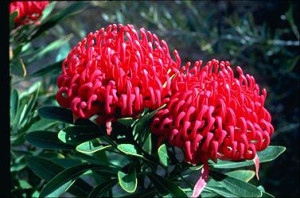In my last post I talked about some of the environmental concerns surrounding the cut flower industry, namely pesticides, water use, and the movement of parasites and diseases. While there are many other facets to growing flowers for bouquets, I want to highlight two other issues, both of which I think we can influence: wildflower harvesting and the social impacts of the flower trade.

One of the five waratah species- photo by MD Crisp and courtesy of the Australian National Botanic Gardens
While the majority of flowers we buy in stores are raised in greenhouses, it turns out that there is a flourishing trade in wildflowers as accent pieces or filler for bouquets. The challenge is to ensure that the harvest is sustainable. In some cases this means certifying that the flowers were not poached from protected areas– in Australia, for example, there is already a sustainable cut-flower industry for waratah flowers, the emblem of New South Wales, but poachers have been taking the blooms from wild stands even though it is protected (Beckers & Offord 2010). Along monitored transects up to 32% of flowers were lost, and there is concern for future populations because seeds don’t remain viable for a long time and new plants are only recruited to the population after wildfires, so fresh seeds need to be waiting. In other cases, we need to make sure that rates of harvest don’t reduce genetic diversity and outpace rates of growth. One of the challenges within the flower industry in general is that the industry itself has become more streamlined and simplified, with retailers (like Tesco or Sam’s Club) talking directly to growers and fewer, more standard varieties in cultivation, while at the same time there is public demand for novelty flowers (Heywood 2003), so suppliers keep looking to wild plants for the latest new thing. But if we overexploit wild populations and reduce both population size and genetic diversity, those wild stocks may not be able to survive and adapt to natural disasters, changing climates, or other challenges.
And the rapid expansion of cut-flower farming into developing countries has had social impacts. On the positive front, Newman (2002) reported that men and women in Ecuador who worked in the flower industry had less wage disparity between the sexes than workers in other industries, and married men in the flower industry did more housework than men in other industries. On the negative side, because wages can be based on individual production and flowers need attention 7 days a week, people may work long hours without gaining substantial returns, and in Ecuador Korovkin (2003) documented both a trend away from young women starting independent households and less time spent on childcare in general because parents aren’t paid high wages and work overtime. Plus, as I mentioned in my last post, there are high rates of pesticide exposure and, in addition to causing headaches and rashes, researchers have documented that women in the cut-flower industry can have problems with reproductive health (Handal & Harlow 2009).
At the start of this post, I mentioned that I thought we could have an influence on these issues, and I think we can get at both of these, plus the water-use concern, through voicing our opinions about how we want workers and ecosystems to be treated and by being willing to accept flowers that are not perfect, both in appearance and seasonality. A number of national and international organizations have been formed to address issues like pesticide and water use, worker’s rights, and sustainable harvesting of natural resources. Whether looking at Flor Ecuador, the Flower Valley Conservation Trust in South Africa, or the larger global entity of Fairtrade International, there are bodies that monitor and certify whether flowers are farmed in a responsible manner- we just need to pay attention to the symbols (Raynolds 2012). And we need to appreciate flowers with blemished leaves and accept that certain flowers may be unavailable during specific months- changing consumer expectations would allow more farms to utilize organic methods and reduce energy and water waste.
So there are problems with cut flowers, but also solutions- in my final post, I’ll see what I can find about how we can make a direct difference.
Works cited:
Beckers, D and CA Offord. 2010. Waratah theft in Brisbane Water National Park- an analysis of the blue paint poaching reduction program. Cunninghamia 11: 287-293.
Handal, A and S Harlow. 2009. Employment in the Ecuadorian cut-flower industry and the risk of spontaneous abortion. BMC International Health and Human Rights 9: 25.
Heywood, V. 2003. Conservation and sustainable use of wild species as sources of new ornamentals. Acta Horticulturae 598: 43-53.
Korovkin, T. 2003. Cut-flower exports, female labor, and community participation in highland Ecuador. Latin American Perspectives 30: 18-42.
Newman, C. 2002. Gender, time use, and change: the impact of the cut flower industry in Ecuador. The World Bank Economic Review 16: 375-395.
